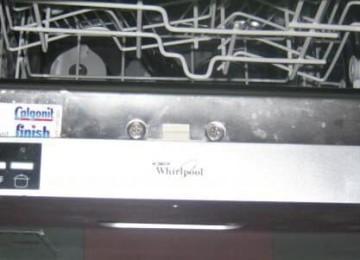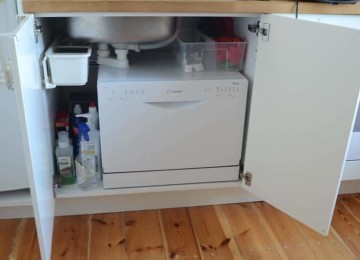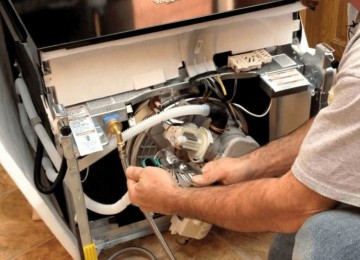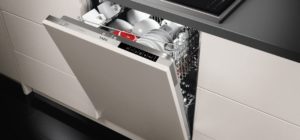 Absence of mechanical damage
Absence of mechanical damage
How to check a used dishwasher when buying
Conclusion
Most housewives dream of buying a dishwasher (PMM) to forget about the daily routine and free up time for the family. However, not everyone understands that you need to approach the purchase of equipment with all responsibility: take into account all the nuances of the unit, calculate the dimensions, conduct a thorough inspection for external cracks, chips, dents, etc. This should be done in the store. But how to check the dishwasher when buying, we will find out below.
Checking the dishwasher when buying
Where to start the check? First, we choose a model that meets all our requirements, and then we decide on other characteristics.
Comparison of the dimensions of the dishwasher and the kitchen
This is done simply. We measure the place where we plan to install the unit: width, height, depth, and compare them with the PMM you like. 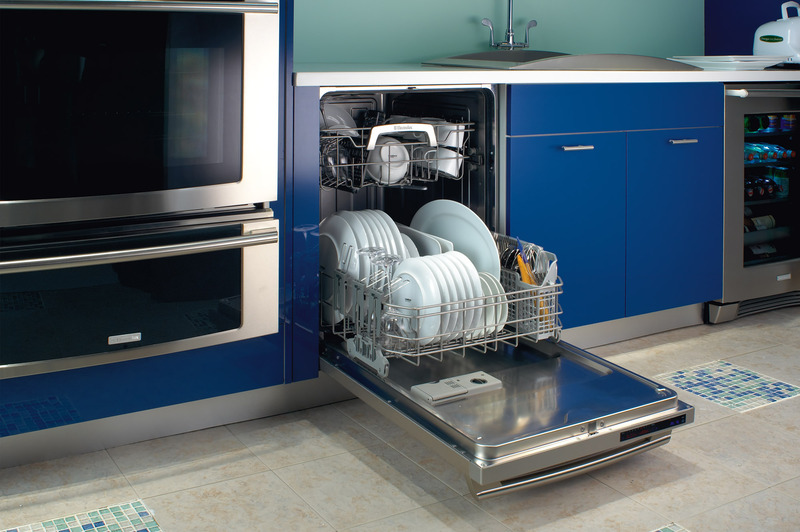
You can stop your choice on full-size devices, up to 0.9 m wide, or on narrow models, no more than 0.5 m wide.How to check a dishwasher before purchasing? - washer.tomathouse.com
Repair
Wash
- Exploitation
- Dishwashers
- Purchase
- Accessories
- Miscellaneous
- Reviews
- Home page
Dishwashers
How to check a dishwasher before purchasing?
CONTENT
- Checking the dishwasher upon purchase
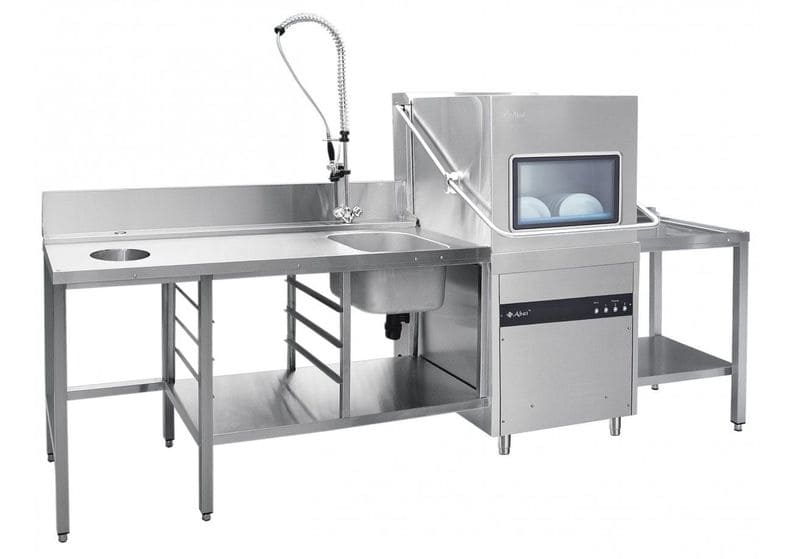
- Comparison of dishwasher and kitchen sizes
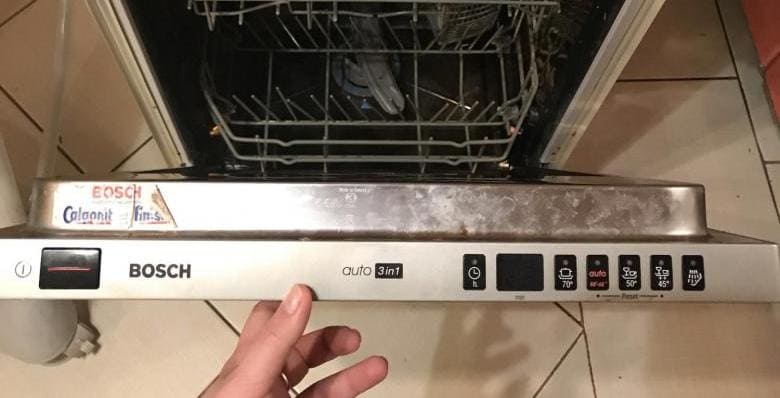
How to choose dishwasher capacity
Classification of dishwashers
Full size
- Compact
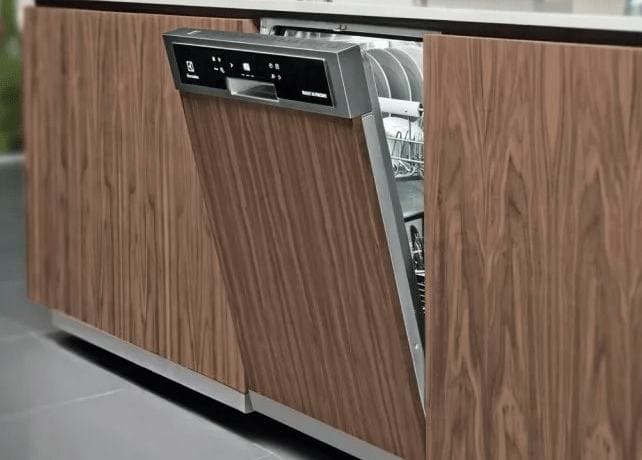
- Narrow
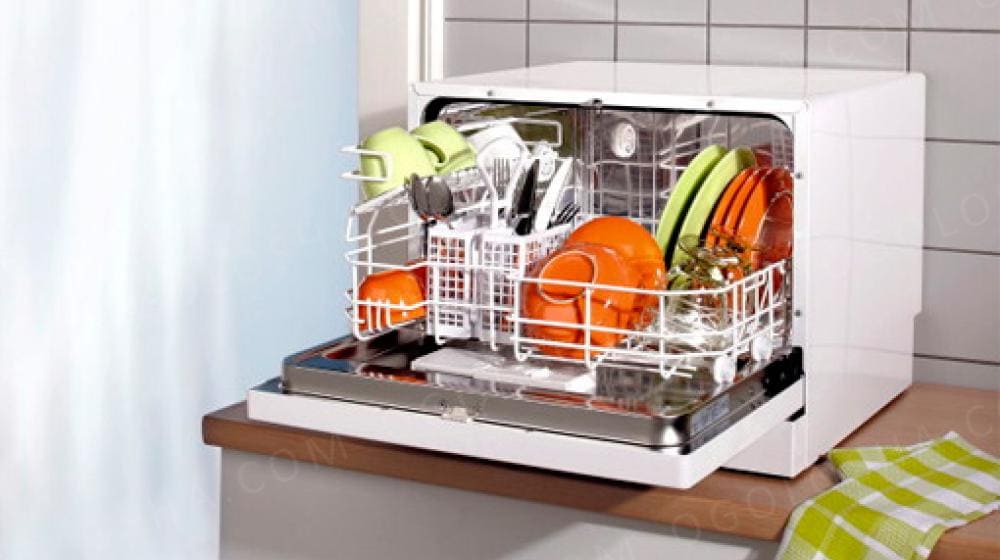
What types of drying exist?
Active
Convection
- Condensation
- Intensive
- Zeolite
Arrangement of containers for dishes
Dishwasher program set
- Dishwasher Accessories
- No mechanical damage
- How to check a used dishwasher when buying
Conclusion
Checking the dishwasher upon purchase
Where to start checking? First, we select a model that meets all our requirements, and then decide on other characteristics.
- Comparison of dishwasher and kitchen sizes
- This is done simply. We measure the place where we plan to install the unit: width, height, depth, and compare them with the PMM we like.
- The choice can be made on full-size devices, up to 0.9 m wide, or on narrow models, no more than 0.5 m wide.
If there is enough space in the apartment, then floor-standing appliances are suitable; if there is little space, table-top appliances, the size of which are comparable to a microwave oven.
It is advisable to decide in advance on the type of dishwasher: built-in or freestanding. If there are no problems with freestanding appliances, then built-in appliances may require additional finishing in the kitchen. This applies to PMM, the door of which is designed for attaching a facade panel. Such machines have an unpresentable appearance, and the control panel is located at the end. If such a unit is installed without finishing, the interior of the room will suffer greatly.
You can opt for partially built-in machines, in which the control panel is located on the door. They are installed in a furniture niche, have a quite presentable appearance and do not require additional finishing steps.
How to choose dishwasher capacity
Capacity depends on the size and type of machine. If the tabletop appliances wash no more than 5-6 sets of dishes at a time, then the full-size one will fit up to 16 sets, and the narrow one – up to 9.
The concept of one cookware set includes:
no more than 3 plates of different sizes;
one glass;
three spoons;
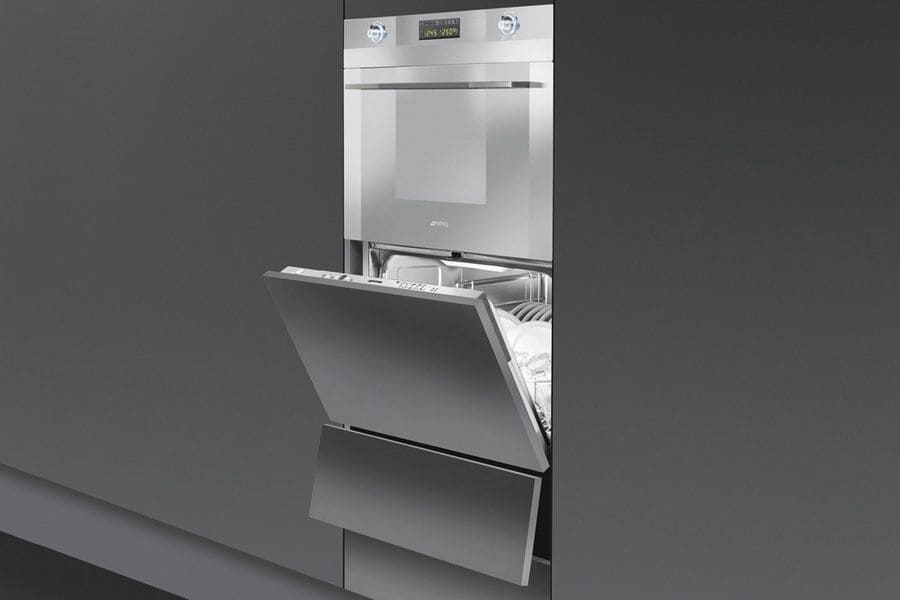
knife;
fork;
- cup;
- saucer.
- The eleven items listed are called a dinnerware set.
- Classification of dishwashers
- There are two types:
Industrial.
Household.
- The industrial version is used in catering establishments, hotels, canteens, etc. Their task is to wash a large amount of dirty dishes efficiently, economically and quickly.
- The household version is used by housewives in the kitchen. Their task is to wash dishes in small quantities.Multifunctional, inexpensive machines with an attractive design are in demand.
- Depending on the chosen installation method, they are divided into:
built-in;
freestanding.
For the first option, they allocate space in the kitchen unit or specially order furniture. In this case, the PMM is open and can be seen. There is an option when you can place the equipment by covering it from view with a tabletop or partially covering it with a facade. This is the most popular variety. Among the built-in models, there are always premium machines.
- Free-standing units can be either table-top or floor-mounted. The floor type is characterized by an aesthetic appearance and original design. Tabletop ones are small in size.
- Depending on the size of the dishwasher, there are:
- full size;
compact;
narrow.
Full size
- The first option is the most spacious. Suitable for large families. Dimensions may vary depending on the modification, but the standard standards are as follows:
- width – 0.6 m;
depth – from 0.55 to 0.6 m;
height – from 0.80 to 0.87 m.
At the same time, this unit can accommodate up to 17 sets of dishes. In stores you can find a full-size version, both built-in and free-standing.
Note to the owner! Combined full-sized PMMs have appeared on the market, which can be combined with an oven or stove. The cost of such equipment is high, but it's worth it!
Compact
These are small machines that do not have specific standards. Dimensions may vary in the range:
width – from 0.5 to 0.69 m;
in height - from 0.45 to 0.6 m.

Suitable for a small kitchen. Take no more than 9 sets at a time.
Narrow
A distinctive feature is its small width (up to 0.49 m). This is almost 20 cm less than the width of a standard full-size PMM. In terms of height and depth, they are practically no different from other dishwashers. Usually they are bought for a small kitchen. Suitable for a small family, as it can accommodate 8-9 dinnerware sets at a time, no more.
Depending on the quality of washing and drying, as well as energy consumption, dishwashers are divided into classes.
The ideal washing quality is designated “A” and “B”. When marking “C” minor errors are allowed. Dishwashers of lower classes clean worse.
If we talk about drying, class A machines do an excellent job and completely dry the dishes. B and C markings allow for slight condensation. With machines belonging to a lower class, the dishes remain wet.
They also designate classes based on energy efficiency. They show the level of electricity consumption of the machine. The higher the class, the lower the costs for energy and water.
What types of drying exist?
Drying dishes is the final stage of the PMM operation, during which residual water is removed from the dishes. Depending on the chosen model, the drying technology may be different.
- Drying types:
- active;
- convection;
- condensation;
intensive;
zeolite.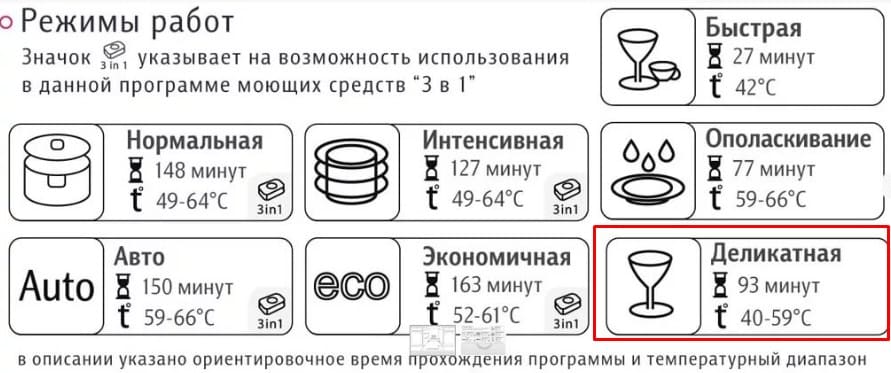
Active
Drying is carried out by a heating element, which forcibly heats the bottom. The operating principle is as follows:
The bottom heats up and increases the temperature of the chamber.
- The moisture begins to evaporate.
- The condensate “evaporates” through the ventilation outlet.
- When choosing this type, housewives need to know that the consumption of electricity and water will be high. This is a significant drawback of the active drying method.
- Convection
- It is carried out due to forced turbo blowing with hot air. In such models, a heating element and a fan are installed. To make moisture evaporate more efficiently, special products are added to the water. The technology is as follows:
- At the end of washing, the dishes are treated with hot water.
A fan is connected to work, which begins to circulate air.
The flow coming out through a special hole cools down and returns to the chamber.
The unit is equipped with additional elements that affect the cost of the dishwasher. In addition, the amount of energy consumed increases.
The simplest type, the operating principle of which is based on the effect of temperature difference and condensation. At the end of the wash, rinse with hot water. As a result of the temperature difference between the walls of the compartment and the dishes, steam is formed, which settles on the surface and flows into special drain holes. Advantages of the condensing type:
no noise:
does not consume energy, since the process takes place when the PMM is turned off.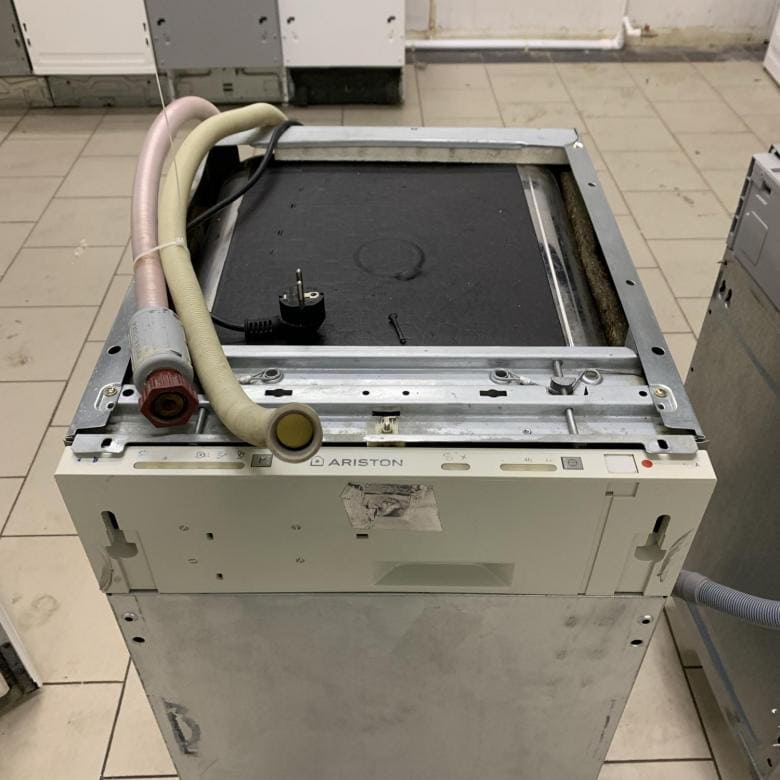
On a note! Despite its advantages, the condensation type of drying a dishwasher takes a long time and can take several hours. The disadvantage is that there is a possibility of streaks forming on plates, cups and other utensils.
- Intensive
- A technological method that includes the advantages of condensation and convection methods. The operating principle is based on air circulation resulting from the difference in pressure in the chamber and the reservoir.
- The process is fast and does not require additional electricity.Units with intensive drying have a complex design with additional elements. Their cost does not exceed the price of convection devices, but they are more expensive than condensing devices.
- Zeolite
- A special type used in premium PMM. The most effective method that combines the advantages of previous technologies.
- The temperature of the chamber is maintained by a natural mineral – zeolite, located in the lower part of the “bunker”. When moisture comes into contact with it, heat is generated. The process is fast and does not require additional energy costs. This method dries dishes perfectly.
- Reference! The mineral ensures proper quality of work. Natural material is durable and will serve for the specified service life. The only negative is the high cost.
- Arrangement of containers for dishes
The standard is considered to be two containers, differing in size and capacity. The lower basket is designed to accommodate plates and large utensils. Small dishes, cups and glasses are placed in the top. Glass wine glasses are secured with holders before washing.
Trays can be either removable or retractable. Some models are equipped with an additional container designed for knives, forks and spoons. This is not a mandatory element of the PMM, but desirable. It is believed that cutlery in a tray is easier to clean and does not scratch other items. Having an additional container is also convenient because you can wash small dishes in it, such as lids, bowls, etc.
The quality of washing depends on the design of the container. If you distribute the kits correctly, you can get rid of contamination at once. When choosing, you must take into account the availability of folding holders.With their help, you can adjust the basket to wash any dishes, including large items, such as baking sheets or large dishes.
Another important point that is also worth considering is the ability to change the height of the container mount. If this is possible, then the upper basket can be raised higher, thereby freeing up more space for the lower one.
Note to the housewife! There should not be a lot of plastic in the chamber. The aggressive environment of the detergent will spoil them and make them brittle. This applies not only to dishes, but also to trays, clamps, holders and other plastic items.
Expensive equipment is equipped with stainless steel components. The advantages of a steel coating are durability and long service life. The metal perfectly reflects heat and maintains an optimal temperature regime. Plastic containers are lightweight, but not durable. They do not have the advantages of metal, so they will have to be changed more often.
Another important point is the shape. Containers should be selected taking into account the size of the dishes present in the kitchen. When checking, you need to make sure that the kitchen utensils can be placed in the container and washed.
Dishwasher program set







